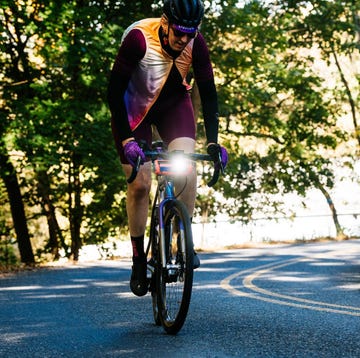Maybe you signed up for a century ride months ago and forgot to pencil it in your calendar. Maybe you put your name down for one on a whim after some friendly encouragement at happy hour. Maybe you simply decided you needed to set and reach a new goal—fast.
Get Bicycling’s Guide to How to Master the Century
Whatever your reason for feeling underprepared for a 100-miler that’s a month out, our four-week century ride training plan can help you make it to the finish, without feeling utterly and hopelessly depleted at the end.
With the help of USA Cycling-certified coach, Paul Warloski of Simple Endurance Coaching, and certified strength and conditioning coach, Corey Lewis of 1and1, a coaching platform, we put together this four-week century ride training plan complete with strength training and rest day recommendations for cyclists looking for a little tune-up before some three-digit mileage.
Who This 4-Week Century Ride Training Plan Is Designed to Serve
We know your burning question: Can someone who’s never completed a century before train for a 100 miles in just four weeks and successfully complete it? Warloski says it depends (as is often the case in cycling and fitness).
“If the person has been riding and is used to spending some time in the saddle, then sure,” he says—it’s possible. And you could, of course, just power through if you’re not quite ready by the day of, but you should know this increases your chances of injury and lingering soreness. “The more training someone can do, the more comfortable the ride will be,” Warloski adds.
Realistically, though, you want to have an endurance base underneath you, which you should have been building for several weeks, maybe even months. As Warloski says, a good endurance base means “if you’re able to comfortably do a 60-mile ride, you can do the century [in four weeks].”
If you think you’ll need more time, check out our longer century training plans, designed for all levels.
Your 4-Week Century Ride Training Plan
Now that we’ve covered who this program is suitable for—intermediate to advanced cyclists who can complete a 60-miler—let’s get into the plan.
How many days per week will you ride?
Building up to a 100-mile ride in just four weeks is a big commitment, even if you can currently ride more than half of that distance. But if you’re already bike-fit for 60 miles, you may be pleasantly surprised to learn that you don’t need to be in the saddle seven days a week.
Warloski says he’d recommend a minimum of three training sessions per week, although he points out that “the more you get in on a daily basis, the more comfortable your ride will be,” adding that an “increasingly long ride with fueling practice is kind of the key.”
Based on Warloski’s recommendations, our four-week century ride training plan includes three bike workouts a week.
What kind of training sessions will you be doing throughout the plan?
The plan consists of three cycling sessions per week, two strength-training sessions, and two rest days with optional (but encouraged) recovery work, such as dynamic stretching and yoga.
Your bike workouts will consist of one long endurance ride, one threshold workout, and one anaerobic power interval workout. We also added in optional easy rides on gym days and rest days in case you’re really yearning for more miles and just want more time in the saddle.
Here’s the general format you can expect:
- Monday: Bike threshold intervals
- Tuesday: Strength training
- Wednesday: Rest, recovery work
- Thursday: Bike anaerobic power intervals
- Friday: Strength training
- Saturday: Long endurance ride
- Sunday: Rest, recovery work
All of your cycling workouts factor in your functional threshold power a.k.a. FTP, which is your average power output for about an hour. It’s helpful to know this number ahead of jumping into training so you can hit your target power zones. Don’t know your FTP? You can try a 20-minute test.
Week 1
Week 2
Week 3
Week 4
What to Know About Strength Training
If you already engage in regular strength training, great! Don’t stop now, even as you bump up your cycling volume, because strength training plays a vital role in injury prevention for endurance athletes, says Lewis, who is also a certified personal trainer and certified strength and conditioning specialist.
“By incorporating exercises that target the muscles and joints used during cycling, such as the quadriceps, hamstrings, glutes, and core, strength training helps to improve muscular imbalances and stability,” Lewis explains. “This, in turn, reduces the risk of overuse injuries and improves overall biomechanics, leading to better form and reduced strain on the body during long rides.”
If injury prevention isn’t enough to convince you to hit the weights, you should know that strength training also improves overall performance and efficiency.
“Cycling primarily targets the lower-body muscles, and strength training helps to develop these muscles further, leading to increased power output and pedal stroke efficiency,” Lewis says. “It also helps to enhance muscular endurance, allowing cyclists to maintain a higher level of effort for longer durations, ultimately improving their overall endurance capacity.”
Not sure what to do in the weight room? Lewis offers some examples:
For an endurance athlete preparing for an intense training block, a well-rounded strength-training program should focus on functional movements and muscle groups specific to cycling, he explains.
This includes exercises such as squats, lunges, deadlifts, step-ups, and core exercises like planks and dead bugs. These exercises help to strengthen the lower body, improve pedal stroke efficiency, and enhance overall stability and balance on the bike.
Additionally, incorporating plyometric exercises like box jumps and medicine ball throws can help improve explosive power, which is beneficial during sprints or challenging climbs.
A word of caution: “It should be known that it’s important to balance strength training with the athlete’s overall training load, ensuring adequate recovery between sessions to avoid overtraining,” Lewis says. Translation: If you feel like you need a rest day instead of strength training, take it.
How to Nail Your Nutrition During a Century
Being super fit can only get you so far if you don’t know how to properly fuel for a long ride—even the fittest consistently consume calories, carbs, and electrolytes in the saddle.
In fact, Warloski says that fueling is typically the biggest issue among beginner to intermediate riders with a long endurance goal.
“On all of the long rides, you should be practicing fueling, both food and hydration,” Warloski says. “With food, you should aim for 60 grams an hour of carbohydrate. That’s a lot, and you can work on trying different foods, including gels, sandwiches, and peanut butter balls. Stay on top of hydration with a bottle an hour with some electrolytes.”
4-Week Century Ride Training Plan FAQs
How many weeks do you have to train for a century ride?
How long you need to train depends on how many miles you can currently ride comfortably. If you can ride 60 miles without issue, you can work your way up to a century in just a month. A complete beginner should plan for 16 to 20 weeks of training, while an intermediate rider capable of riding 30 to 40 miles currently should plan for eight to 12 weeks.
Can you cycle 100 miles without training?
It is not recommended to go for a 100-miler without any prior training. This could set you up for extreme muscle soreness, fatigue, or injury.
How can I cycle long distances without getting tired?
Train, train, train! The only way to ride longer distances is to accumulate more time in the saddle and practice all of the skills you need for a successful ride: endurance, strength, power, and bike handling skills.
Strength training can help with all of the above, and mobility work (plus a bike fit) is a must if you struggle to hold proper body positioning on the bike.
Amanda is a content writer and journalist with extensive experience in the health, fitness, lifestyle, and nutrition niches. She is a certified personal trainer and sports nutrition coach, as well as a triathlete and lover of strength training. Amanda's work has appeared in several notable publications, including Health Magazine, Shape Magazine, Lonely Planet, Personal Trainer Pioneer, Garage Gym Reviews, Reader’s Digest, CNET, LIVESTRONG, Health Journal, CleanPlates, Verywell Fit, Verywell Mind, and more.

















